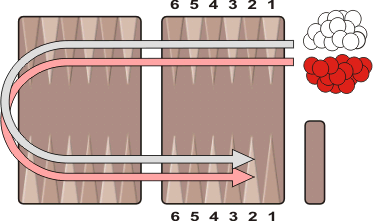![[Backgammon Galore!]](/gif/GaloreButton.gif)
|
|
Backgammon Variants Our knowledge of the rules of Tabula comes primarily from records kept by Emperor Zeno in 480 CE. Setup: The equipment for Tabula is the same as in backgammon except that each player has three dice instead of two. All checkers start off the board. Both players enter their fifteen checkers into the same starting table and move them around the board in the same direction.
Object: The object of the game is to move all of your checkers to the finishing table and then bear them off. The first player to bear off all his checkers wins the game. To start: Each player rolls one die. The player who rolls the higher number goes first. That player then rolls all three of his dice to begin his first turn. Entering checkers: You enter a checker onto the board by placing it on a point in the starting table corresponding to a number rolled. For example, if you roll 6-3-1, then you may enter three checkers, one on each of six-point, three-point, and one-point. However, you may not enter a checker onto a point occupied by two or more opposing checkers. Once you have entered one or more checkers, you may use subsequent rolls to move those checkers forward, to enter more checkers, or both. You may not move a checker to the second half of the board until all of your other checkers have been entered. Movement: The roll of the dice indicates how many points, or pips, the player is to move his checkers. The following rules apply:
Hitting: A checker sitting alone on a point is called a blot. If an opposing checker lands on a blot, the blot is hit and placed on the bar. Entering from the bar: Any time you have one or more checkers on the bar, your first obligation is to reenter those checker(s) into the starting table. You reenter a checker by moving it to an open point corresponding to one of the numbers on the rolled dice. If you are able to enter some but not all of your checkers, you must enter as many as you can and then give up the remainder of your turn. Bearing off: Once you have moved all fifteen of your checkers into the finishing table, you may begin bearing off. You bear off a checker by rolling a number that corresponds to the point on which it resides, then removing the checker from the board. The first player to bear off all fifteen of his checkers wins the game.
References
|
![]()
Backgammon Galore : Variants

